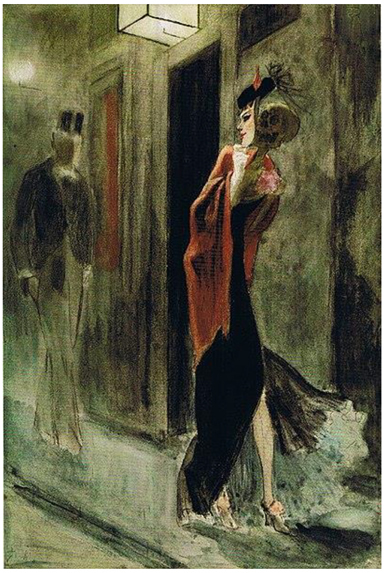
doi.org/10.15198/seeci.2020.53.69-81
RESEARCH
JOKER, OR THE SALVATION OF THE DESPOILS
JOKER, O LA SALVACIÓN DE LOS DESECHOS
JOKER, OU A SALVAÇÃO DO LIXO
Johnny Gavlovski E1.
1Metropolitan University. Venezuela.
[1] Writer. UNIMET professor. Clinical psychologist and psychoanalyst member of the World Association of Psychoanalysis. Coordinator of the Film and Psychoanalysis Network for the New Lacanian School. Professor at the Metropolitan University of Caracas.
ABSTRACT
The success of “Joker” (2019) has been followed by unease and uncertainty. So much for the different way in which the film depicts a character pop culture has pigeonholed in the role of evil and insane clown who must be stopped at all costs; as for the commercial and artistic need to understand the causes of its success or the plot intricacies of the film and its characters. The general feeling is that the devilish clown is given the right to an understandable motivation for the first time. This is not true: the character has historically had deep and well-written motivations. It is the madness of the character - who predates his encounter with Batman and his famous fall into the acid vat- what receives no justification beyond birth-right until the legendary Joker by Heath Ledger, who gave him a typically Freudian personality frame. Phoenix and Phillips take it one step further, delving into the roots of insanity and the collective responsibility of society for those whom the system fails to save. This Joker is allowed to finally star in his own film, not as an excuse for antisocial behavior, but as an explanation of the very complex causes that motivate him compared to the comparatively simple solutions of what society calls public order. And as a warning that sustainable human management is part of a fully functional society.
KEY WORDS: Joker, Joaquin Phoenix, Sustainable Communication, Functional society, Human Management.
RESUMEN
El éxito de la película “Joker” (2019) ha venido acompañado de inquietud e incertidumbre. Tanto por la manera diferente en la que el filme trata a un personaje que la cultura pop ha encasillado en el rol de payaso malvado y demente que debe ser detenido a todo trance; como por la necesidad comercial y artística de comprender las causas de ese éxito o los entresijos argumentales del filme y de sus personajes. La sensación es que al payaso diabólico se le concede por vez primera el derecho a una motivación comprensible. Esto no es cierto: el personaje ha contado históricamente con profundas y bien argumentadas motivaciones. Es la locura del personaje –que predata a su encuentro con Batman y su célebre caída a la cuba de ácido- lo que no recibió una justificación más allá del defecto de nacimiento hasta el mítico Joker de Heath Ledger, que le aportó un cuadro típicamente freudiano. Phoenix y Phillips lo llevan un paso más allá, ahondando en las raíces de la locura y en la responsabilidad colectiva de la sociedad por aquellos a quienes el sistema no logra salvar. Se le permite a este Joker/Guasón protagonizar al fin su propia cinta, no como una excusa del comportamiento antisocial, sino como una explicación de las muy complejas causas que lo motivan frente a las comparativamente simples soluciones de lo que la sociedad llama orden público. Y como un aviso de que la gestión humana, forma parte también del desarrollo sostenible de una sociedad funcional.
PALABRAS CLAVE: Joker, Joaquin Phoenix, Comunicación sostenible, Sociedad funcional, Gestión humana.
RESUMO
O sucesso do filme “Joker” (2019) foi acompanhado de inquietação e incerteza. Tanto pela forma diferente na que um filme trata ao personagem que a cultura pop classificou no papel de palhaço mau e louco que deve ser detido a todo custo; quanto pela necessidade comercial e artística de compreender as causas desse sucesso ou os detalhes argumentais do filme e seus personagens. A sensação é que ao palhaço diabólico é concedido pela primeira vez o direito a uma motivação compreensível. Isto não é o certo: o personagem contou historicamente com profundas e bem argumentadas motivações. É a loucura do personagem – o que é anterior ao seu encontro com o Batman e sua célebre queda no tanque de ácido- o que não recebeu uma justificativa além do defeito de nascimento até o mítico Joker do Heath Ledger, que deu a ele uma personalidade tipicamente freudiana. Phoenix e Phillips levam isto além, aprofundando nas raízes da loucura e na responsabilidade coletiva da sociedade por aqueles a quem o sistema não consegue salvar. É permitido a este Joker estrelar finalmente seu próprio filme, não como uma desculpa do comportamento anti social, mas como uma explicação das muito complexas causas que o motivam frente às comparativamente simples soluções do que a sociedade chama de ordem pública. E como um aviso de que a gestão humana, forma parte também do desenvolvimento sustentável de uma sociedade funcional.
PALAVRAS CHAVE: Joker, Joaquin Phoenix, Comunicação sustentável, Sociedade funcional, Gestão humana.
Translation by:
Paula González (Universidad Católica Andrés Bello, Venezuela).
Correspondencia:
Johnny Gavlovski E. . Metropolitan University. Venezuela.
EJGavlovsku@unimet.edu.ve
Received: 08/06/2020.
Accepted: 17/08/2020.
Published: 15/11/2020.
How to cite the article:
Gavlovski E., J. (2020). Joker, or the salvation of the despoils. [Joker, o la salvación de los desechos]. Revista de Comunicación de la SEECI, 53, 69-81. doi: https://doi.org/10.15198/seeci.2020.53.69-81
Retrieved from http://www.seeci.net/revista/index.php/seeci/article/view/652
1. INTRODUCTION
Put on your costume
and powder your face.
The people are paying, and they want to laugh here.
And if Harlequin steals away your Columbina,
laugh, clown, and all will applaud!
Aria Vesti la Giubba (1892), opera Pagliacci, by Ruggiero Leoncavallo.
We can see an animal tied up, beaten, abused, taken to the slaughterhouse. We can feel sorry for it and there will be someone who remonstrates: “What does it matter? Don’t you eat meat?” We can see caged birds, subjected to hormonal treatment, violated in their nature, trapped in narrow cages to peoduce for us. Just turn your gaze, lament human violence, and continue tasting an exquisite cordon blue or some eggs Benedict. We can even see the drama of the displaced, wars, massacres, terrorist attacks on TV, the internet, on our mobile devices. Or listen undaunted to the denial of the Nazi holocaust, or the current handling of economic convenience, putting it before taking sides in the face of human rights abuses. All this is far away, it does not touch us, it is part of the mass media phenomenon that offers various shows, among which such a blockbuster terror stands out. The end of the film is enough or turning off of our devices to put an end to the act of consciousness. The ominous is outside, abroad, isolated, segregated, and that reassures us.
The history of our Western world is full of tales of the impact of the industrial revolution on our lives. For example, we reviewed English literature and in the work of Ch. Dickens, we understand the place of waste that the human cub had. It took a Jean Jacques Rousseau, to elevate it to the dignity of the Thing, as Lacan would say, based on the work of the German philosopher Georg Simmel; understanding the Thing as that of me, outside of me, the most intimate on the outside, the ultimate.
Thus the dignity of childhood, that is, the beauty of childhood that must be respected is inserted as a virtue in our society, in a symbolic framework of which we are part; and where sexual activity is regularized in an institution called marriage2
[2] We suggest reading Miller, Jacques Alain Salvation through despoils http://www.nel-mexico.org/articulos
2. OBJECTIVES
The objective of this article is to dissect the latest cinematographic phenomenon “Joker” (2019) to give a psychological and culturally reasoned explanation of its content, its message, and its protagonist. An explanation that allows us to understand the scope of the phenomenon and the true dramatic extension of its characters and scenes, to facilitate the understanding of the communicative - or non-communicative - elements that have created this viral and cinematographic phenomenon, in an environment of popcorn premieres and big box-office where the concern for quality is referred to the implementation of the latest digital FX, relegating the performance and the well-written script to the dustbin of film history.
3. METHODOLOGY
I intend to carry out a thorough psychosocial analysis of the events and characters portrayed in the film. Their motivations, background, and relationship with the prevailing society until the reactions arising from this relationship. All this together with the review of the antecedents of the clown-drama tandem as a powerful engine for reporting and reviewing our collective and personal contradictions, as well as the relevant precedents for social reporting in terms of prevailing ethics and ostracism as a protection technique of societies against those who face what they do not want to confront.
4. DISCUSSION
Of course, today, in our world of test-tube babies, artificial insemination, human rights, the word “bastard” has lost its value; but in other times, not far off, by the way, it implied a difference, even a stain on the honor of the home. With what brilliance, the Belgian artist Felicien Rops, in his work “The Human Parody”3 , knew how to denounce by representing the worthy pater familias in his encounter with venereal disease, and then return home, to take his place, and infect his family. That syphilis that no one took care of and was always the cause of the Other: the French called it the Neapolitan disease, the Russians the Polish disease, the Poles the German disease.
[3] Felicien Rops, The Human Parody (1878-1881) watercolor, pastel, chalk (22.5 x 15 cm) Musee Rops, Namur.
Source: the Human Parody (1878-1881).

Figure 1. Felicien Rops.
It was the lapse of the parent, and just like deformed Spartan children, who threatened the cultural ideal, they were expelled, away from the paradise of acceptance.
This is how the different was treated. This is how it is still treated today.
And sometimes the sin of the parents returns as the real of the body, in what we call inheritance, giving us starkly the ghosts of our family nightmares. Henryk Ibsen showed them in his work “Specters”. Released in 1882, and banned since then for having had the audacity to show what must be hidden: the story of the son who is taken away from home so as not to be contaminated by the sins of the father, and returns to die, because inheritance does not forgive.
Source: photo Roland Streuli. Directed by Johnny Gavlovski. Rajatabla Room, 1999.
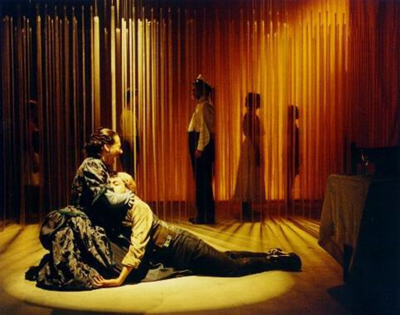
Figure 2. Spectra by H Ibsen.
All this brings us to Joker (2019), a script created for cinema by Todd Phillips and Scott Silver, and where a deep sigh of relief calms the horror that runs through the audience when they understand that the protagonist, Arthur Fleck, does not commit a terrible matricide, but on the contrary, he does justice to a woman who is not his mother, and who also allowed him to be abused as a child. That is to say, crime in its moral connotation appears in our eyes nuanced, elevated to the category of a pretext; thus entering into a series of justifications of the same tenor, from the very moment it is understood why Fleck behaves as he does.
The crime is justified, seems like the first reading of this film, but staying at that leads us to forget that the film directed by Phillips entails a more serious reading: We are all responsible for the malaise of our culture.
The first minutes of the film already make the thesis clear. This man, who takes care of a mother, who is not such; waiting for a father, who does not arrive; who tries to live most honestly in the dark underworld of Gotham City, is mocked, beaten, humiliated, ended up on the floor as a waste of urban violence.
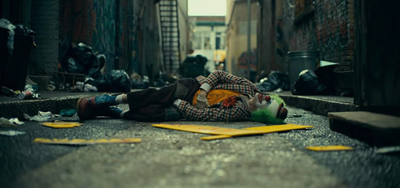
Figure 3. Scene from Joker (2019) Direction: Todd Phillips.
That is the beginning of the thesis of this work. And I say work as the result of the know-how of those who built it, starting with an actor like Joaquín Phoenix, who achieves what many of us considered impossible: to stand alongside the mythical Joker of Heath Ledger. Both artists reach the Olympus of the arts, from different spaces: while Ledger is the Lord of Tartarus, the masterful Phoenix marks the beginning of the descent into the underworld. To do this, he takes acting to another level, to a composition of body and interpretive structure as we have rarely seen in cinema, except in those artists who pass to the level of legend.

Figure 4. Joaquín Phoenix as “Arthur Fleck”.
“MAYBE A LITTLE DECENCY”
How can one not empathize with a character who is crying out for a minimum of dignity?
Arthur Fleck: “I know it seems strange, I don’t mean to make you uncomfortable. I don’t know why everyone is so rude; I don’t know why you are. I don’t want anything from you. Maybe a little bit of warmth, maybe a hug, dad? How about just a little bit of decency!” 4
Fleck tries to insert himself in the world through the semblance of comedy, embodying the desire of the mother.
Arthur Fleck: “My mother always tells me to smile, and put on a happy face. She told me that I had a purpose: to bring laughter and joy to the world” 5, that is, a Joker, a wild card, a signifier at the service of the desire of the Other, that is, that it takes “its value according to the convenience of the player who owns it” 6, ergo, an object of the Other, thus fitting perfectly into the origin of psychoses as Lacan makes explicit in his first approach to these. A child devoured by the desire of the mother, in the absence (foreclosure) of a father (or whoever performs this function) to set limits.
Thus Fleck makes himself exist in that extreme of the clown, in that tragic archetype that Ruggiero Leoncavallo eternalized in his opera Pagliacci, in the voice of Canio, the deceived clown.

But although the verista spirit of Leoncavallo precedes the work of Phillips & Silver, in the Canio of the Neapolitan musician there is no denunciation of an inefficient system towards its citizens, where inserting oneself implies denying its own tragedy. Thus, Fleck writes in his notebook: “The worst part of having a mental illness is people expect you to behave as if you don’t.”
Fleck asks for help and does not get it. And not only because of the ineffectiveness of a health department under corrupt leadership, but for the moment, it was unknown that his pathological laugh was the consequence of gelastic epilepsy, against which drugs could do nothing except through the extirpation of its etiology in a tumor in the hypothalamus. That’s why he laughs, and not like Canio who “Laugh at the pain that poisons your heart!” 8 . Here the dimension of laughter is that of the evidence that something is wrong, something is wrong in his body, something that is intertwined with that which is incapable of being verbalized: anguish. The unfortunate thing is that Arthur Fleck does not have the resources to deal with it; and much less, to make use of that form of the unconscious called a joke, or to defend himself through sublimation. Melanie Klein taught us how in the face of its ineffectiveness, what remains is the inhibition in the subject. But even so, Fleck achieves a name, a name for his enjoyment: Joker
There his attempt to insert himself, to sublimate through comedy. As J-A Miller says: “What is called sublimation affects socialization of jouissance. The enjoyment is socialized, that is, integrated into the social bond” 10
However, unlike Canio who “Turn heartbreak and crying into jokes; in a grimace, sobs and pain” 11 ; Fleck is unable to do so. Again the expulsion, the mockery, the transfer on Murray Franklin to “save the father” and find that “leaky”, “non-existent” space; and the consequent non-recognition as a child, as a “being” other than as an object of use by the Other. That is how it was in his childhood: he was not a child, but a need for Penny Fleck, not a child with rights, but an object of use and abuse by men, to whom she in turn offered herself as an object of satisfaction. And there we understand why Joker’s enjoyment is not “elevated to the dignity of the Thing” 12 , but “lowered to the unworthiness of despoils” 13 , to the impossibility of sublimation.
So, while the film’s discourse runs, the unconscious is left open, and the Lacanian real, that unattainable that is anguish and the impossibility of meaning, hits not only Arthur Fleck, and his world, but also the viewer, violently and implacably. And the Joker declares: “For my whole life, I didn’t know if I even really existed. But I do, and people are starting to notice”. The way, the violence, the crime to which he was pushed.
[4] https://www.imdb.com/title/tt7286456/characters/nm0001618?ref_=ttfc_fc_cl_t1
[5] Op cit.
[6] https://www.google.com/search?client=firefox-b-d&q=comod%C3%ADn
[7] Except from the aria “Vesti la Giubba”, opera Pagliacci by Ruggiero Leoncavallo, translation taken from https://es.wikipedia.org/wiki/Vesti_la_giubba Retrieved October 27th, 2019
[8] Ibid.
[9] https://www.imdb.com/title/tt7286456/characters/nm0001618?ref_=ttfc_fc_cl_t1
[10] Miller, Jacques Alain Salvation through despoils http://www.nel-mexico.org/articulos Retrieved October 26th, 2019.
[11] Leoncavallo, R:“Tramuta in lazzi lo spasmo ed il pianto/ in una smorfia il singhiozzo e ‘l dolor” Op cit.
[12] Lacan, J. (1988), La ética del psicoanálisis, Libro 7, Clase XII Edit Paidós. Buenos Aires. Pág. 138.
[13] Ibid.
5. CONCLUSION
“In that body, unforeseen things happen”14The reason we dance is because there are many things that we don’t understand.
Kazuo Ohno
Catharism was a heretical current of the 12th century, which alarmed the Catholic Church given some approaches, among them, how they assumed the dualistic idea of the endless struggle between Good and Evil. What is particular about them is that they played that battle in the body itself. Thus, the Good, oriented them to “purity and light, a world of the true, of the original good Creator, whose creation had been sullied by the intervention of the evil creator, the Demiurge”15 , who had created the world and everything material that it involves; and as a consequence of this: “putrefaction, that is, transformation”, ergo, “Evil is in matter”16
Consequently, it cannot surprise us then that Joker arises from the body, from a dancing body. “In that body unforeseen things happen... and unforeseen things happen precisely because the body, the body we speak of in psychoanalysis, is a disturbed, modified body, deeply marked by the signifier, that is, by the Other and by the real”17 Lacan called it “mortification of the body”, and he developed that idea until he came to understand the body as “affected by the Other, affected by the significant articulation, affected by the significant marks that will subject the body and the image”18. Thus, we can understand the Joker from the event of the body.
In this way, from the mortification of the body of the actor Phoenix19 to that of the character Arthur Flake, they will give that symptom called Joker. A character that is literally born from the language of the body, in the improvisation of the actor, through the music of Hildur Guðnadóttir. It seems inspired by the dances/performance: Ankoku but? (????), the dance of darkness, created by Kazuo Ohno and Tatsumi Hijikata (1950)
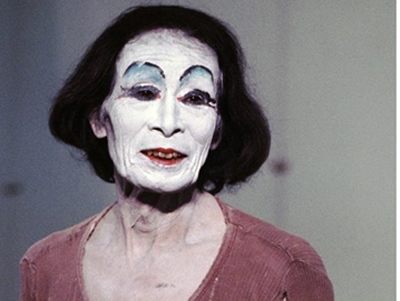
Figure 5. Kazuo Ohno (1906-2010).
A dance of rupture, born “within the post-war context in a Japan at that time devastated (…where there was) proliferation of spaces in which it was revealed, on the one hand, the fall of the values that had previously governed daily life, and, on the other, the need and desire to create something new”20.
The etymology of Ankoku but? comes from Buyo “neutral word for dance and has the root of the words “jumping” or “hoping” that Tatsumi Hijikata “decided to name only as: Butoh” “to distinguish it from both Western dance and traditional Japanese dance” amen that the suffix “toh implies stepping firmly, rooted to the earth” In this way, while Buyoh, “is the ascending, Butoh is the descending”21 , being able to be interpreted as “the dance of descent in darkness”, understanding this, according to Natzue Nakajima in “that without form, that which cannot be expressed in words”22 Again, the Real insists.


Figure 5.2. Dance-butoh24.
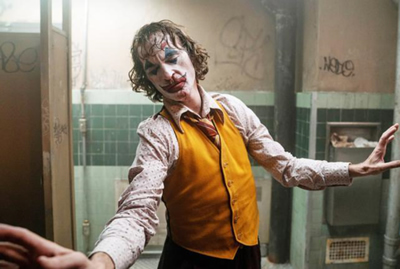
Figure 6. Joker (2019) Dir: Todd Phillips.
Like a deceased, Arthur Flake seems to descend into Hades. The landscape of darkness, violence, fire, and death serve as the setting for the final accident scene. We can believe him dead, waste on the hood of the car; but as a sinister phoenix he will be rescued from his ashes by others, fellow men, who, like an image in the mirror, give him back a great image of himself, discovering an apocalyptic world, like the one where the Ankoku but? arose.
But now the Joker doesn’t dance; now he contemplates, contemplates and acts from the pit of madness; without realizing that through the longed-for recognition of the Other, he will continue to be used by those who need a sad clown, a populist puppet.
[14] Tarrab, M citing J-A Miller in his 1999 course, http://pepsic.bvsalud.org Recupe 27 Oct 2019.
[15] Lacan, J. (1955) El Seminario, Libro 7, La ética del psicoanálisis. Edit Paidós, Buenos Aires. Pág.153.
[16] Op cit Pág 154.
[17] Tarrab, M. Op cit.
[18] Ibid.
[19] AN.: who lost 23 kilos in 4 months to be able to interpret his role.
[20] Pérez Monjaraz, Nayeli The deterritorialization of the body. A reflection on the Butoh dance http://reflexionesmarginales.com/3.0/la-desterritorializacion-del-cuerpo-una-reflexion-acerca-de-la-danza-butoh Reflexiones Marginales - ISSN 2007-8501 Awarded by the National Center of the ISSN Retrieved October 27th, 2019.
[21] Op cit.
[22] https://es.wikipedia.org/wiki/ Recuperado 27 octubre, 2019.
[23] Reflexiones Marginales. Op cit. Ibid.
[24] Ibid.
AUTHOR
Johnny Gavlovski E.
Writer. UNIMET professor. Clinical psychologist and psychoanalyst member of the World Association of Psychoanalysis. Coordinator of the Film and Psychoanalysis Network for the New Lacanian School. Professor at the Metropolitan University of Caracas. EJGavlovsku@unimet.edu.ve